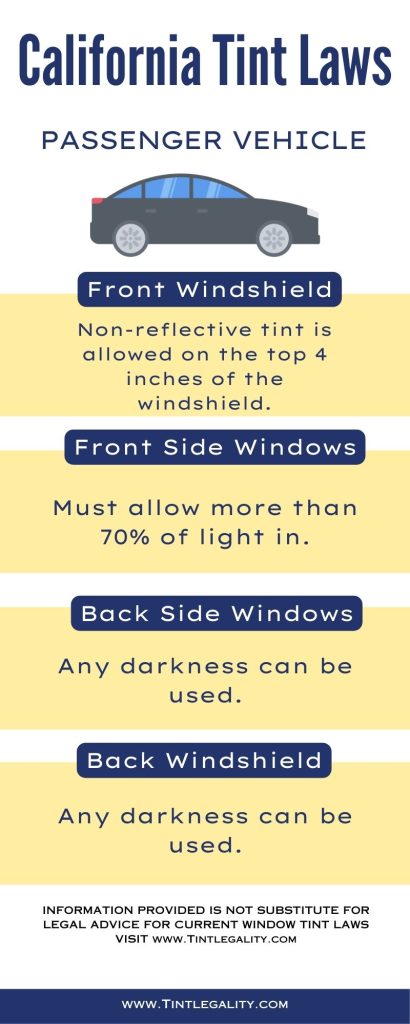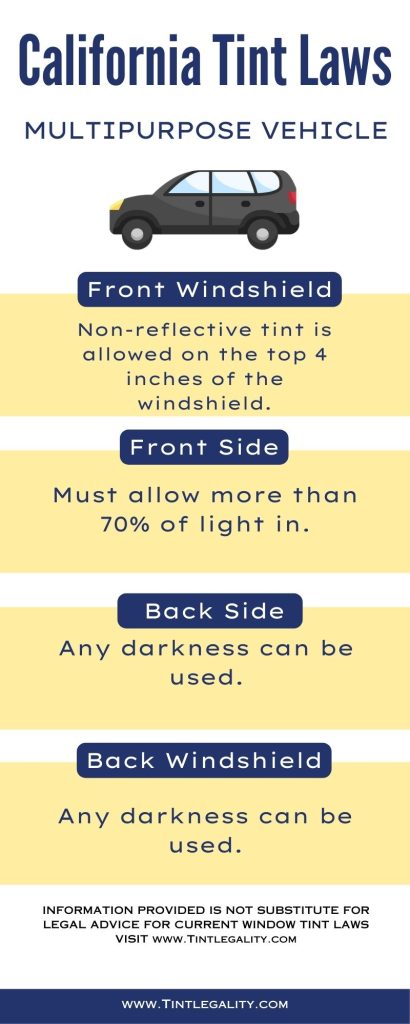If you’re a car owner in California, you may be wondering about the state’s tint laws. What exactly are they?
And what do you need to know to stay within the legal limits?
California tint laws were enacted in 1999 and were updated in 2019 to clarify certain aspects of the law.
These laws regulate the amount of tint that is allowed on a car’s windows.
The purpose of these laws is to ensure that drivers can see clearly on the road and to promote safety on California’s highways.
In this article, we’ll look at the regulations regarding window tints in California, including what types of tints are allowed and what the penalties are for breaking the law.
Regulations Regarding Window Tint in California
Windshield
The front windshield of a car must allow at least 70% of light to pass through it.
This means that you cannot use a dark tint on your front windshield.
However, you are allowed to use a clear, colorless tint on the top 4 inches of the windshield.
| Window | Tint Limit |
|---|---|
| Windshield | 70% visible light transmission |
| Front Side Windows | 70% visible light transmission |
| Back Side Windows | No tint limit (with 200 feet of visibility behind the car) |
| Rear Window | No tint limit (with 200 feet visibility behind car) |
Front Side Windows
The front side windows of a car must also allow at least 70% of light to pass through them. This means that you cannot use a dark tint on your front side windows either.
However, you are allowed to use a clear, colorless tint on the top 4 inches of the front side windows.
Back Side Windows
The back side windows of a car can be tinted to any darkness level as long as the car has side mirrors that provide at least 200 feet of visibility behind the car.
Rear Window
The rear window of a car can also be tinted to any darkness level as long as the car has side mirrors that provide at least 200 feet of visibility behind the vehicle.
Additional Regulations
In addition to the regulations listed above, there are a few additional regulations that you should be aware of if you’re considering tinting your car’s windows.
Reflection
The tint on a car’s windows cannot be too reflective.
Specifically, the front side windows cannot reflect more than 70% of light, and the back side windows and rear windows cannot reflect more than 60% of light.
Medical Exemptions
If you have a medical condition that requires you to have a darker window tint, you may be able to obtain a medical exemption from the state.
To obtain a medical exemption, you will need to provide a letter from your doctor explaining your condition and why a darker window tint is necessary.
Color Restrictions
The tint on a car’s windows cannot be red, blue, or amber. These colors are reserved for emergency vehicles only.
Side Mirrors
If your car has a tinted rear window, it must also have side mirrors that provide at least 200 feet of visibility behind the car.


Exceptions to Legal Limits
There are a few exceptions to the legal limits on window tint in California.
For example, if you drive a limousine or a vehicle used for funeral services, you are allowed to have a darker window tint.
Penalties for Breaking the Law
So, what happens if you break the window tint laws in California? Here are the penalties you can expect:
Fines
If you’re caught with illegal window tint, you will be fined. The amount of the fine will depend on how many times you’ve been caught breaking the law.
First Conviction
If this is your first conviction for illegal window tint, you will be fined $25.
Second Conviction
If this is your second conviction for illegal window tint, you will be fined $50.
Third Conviction
If this is your third or subsequent conviction for illegal window tint, you will be fined $100.
Other Penalties
In addition to fines, you may also have to remove the illegal tint from your car. If you refuse
to remove the tint, your car can be impounded until you comply with the law. Additionally, having illegal tint on your car can also result in points on your driver’s license.
Penalties for Non-Compliance
If you are unable or unwilling to comply with the law, you may be subject to additional penalties. For example, if you’re caught driving with illegal window tint and you don’t have a valid driver’s license or insurance, you could face even more severe penalties.
Benefits of Legal Tint
While it may seem like a hassle to make sure your car’s window tint is within the legal limits, there are some benefits to having a legal tint on your car.
For one thing, legal tint can still help protect you from the sun’s harmful UV rays.
Additionally, legal tints can help keep your car cooler in the summer months, which can be a lifesaver on hot days.
Is a 35% tint legal in California?
No, a 35% tint is not legal on front and back side windows in California.
Is 30% tint legal in CA?
No, a 30% tint is not legal on front and back side windows in California.
What is the tint law in California 2023?
The current tint law in California is the same as of 2021: 70% visible light transmission on front and back side windows.
How much is a tint ticket in CA?
The fine for illegal tint in California is $25 for first conviction, $50 for second, and $100 for third.
References:
https://en.wikipedia.org/wiki/California
https://leginfo.legislature.ca.gov/faces/billTextClient.xhtml?bill_id=201720180AB1303